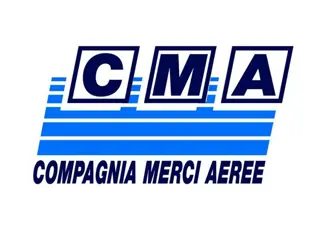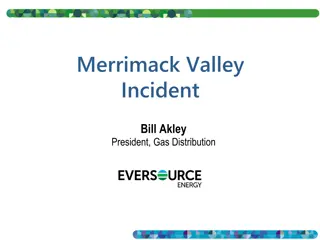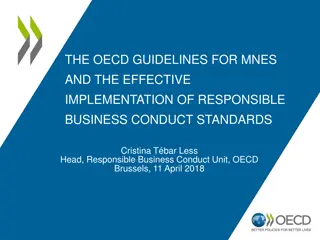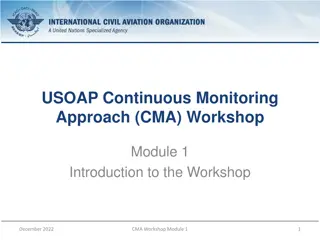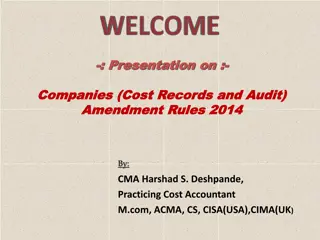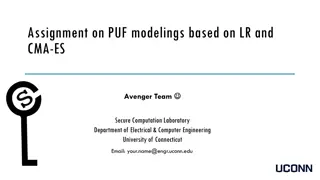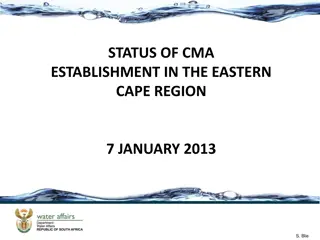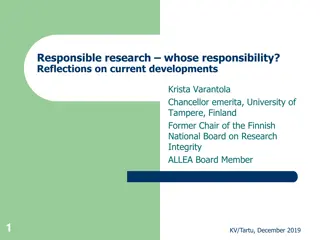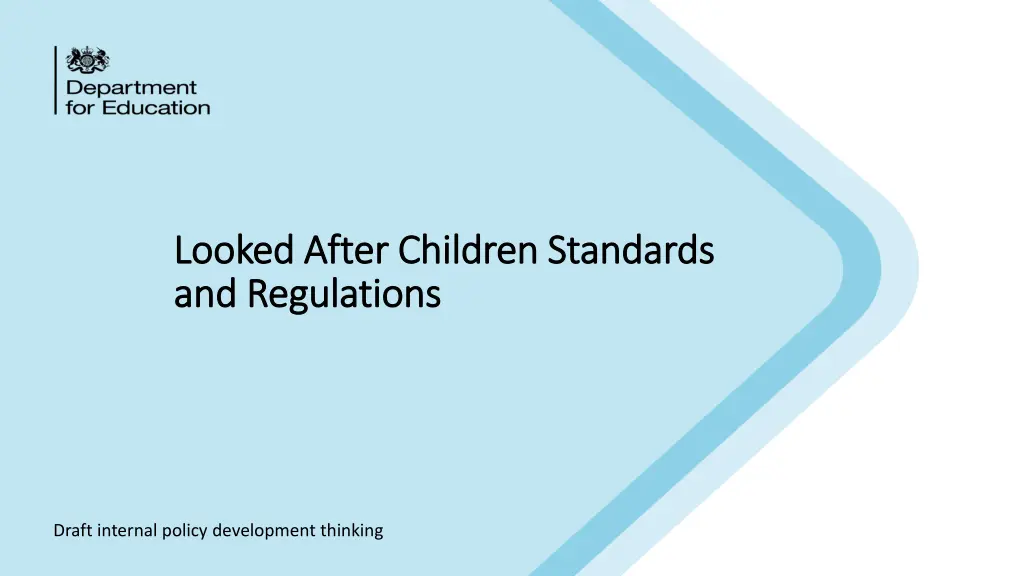
Developing Internal Policies for Looked After Children Standards
Enhance the quality of care for looked after children by developing internal policies in alignment with regulations and standards. Explore the key legislation, regulations, and guidance underpinning foster care and children's homes in England. Stay informed about proposed care standards to ensure all children in care receive the support they need.
Uploaded on | 1 Views
Download Presentation

Please find below an Image/Link to download the presentation.
The content on the website is provided AS IS for your information and personal use only. It may not be sold, licensed, or shared on other websites without obtaining consent from the author. If you encounter any issues during the download, it is possible that the publisher has removed the file from their server.
You are allowed to download the files provided on this website for personal or commercial use, subject to the condition that they are used lawfully. All files are the property of their respective owners.
The content on the website is provided AS IS for your information and personal use only. It may not be sold, licensed, or shared on other websites without obtaining consent from the author.
E N D
Presentation Transcript
Looked After Children Standards Looked After Children Standards and Regulations and Regulations Draft internal policy development thinking
The context Care Review New and ambitious care standards, applicable across all homes for children, should be introduced. In Stable Loving Homes we said: We are reviewing all legislation, regulations and standards of care to ensure all children in care receive what they need, no matter where they live. We have set up an expert working group to review all existing legislation and regulations and to develop a core overarching set of standards for fostering, children s homes and supported accommodation. Competition and Markets Authority study of the children s social care market We recommend that the UK Government carries out or commissions a review of regulation impacting on the placements market in England. We recommend that the UK and Welsh governments review the impact of the planning system on the ability of providers to open new children s homes. Commitment in response to the National Panel report on residential special schools run by the Hesley Group: Strengthen the standards and regulations governing the care of children who are looked after to ensure consistently high-quality provision and inspection, with a high level of ambition for all children; Work with Ofsted to strengthen its inspection and regulatory powers to hold private providers of children s homes to account; Not for wider circulation - Internal policy development thinking 2 Strengthen the National Minimum Standards for residential special schools
Not for wider circulation - Internal policy development thinking 3
Not for wider circulation - Internal policy development thinking Key Legislation, regulations and guidance underpinning foster care and children s homes in England: The Children Act 1989 - Sets out the general framework in respect of LA support for children and families, duties of LAs towards looked after children and care leavers and LA protection of children. Accompanying guidance and regulations is organised in 5 volumes: The Children Act 1989 Guidance and Regulations Volume 1: Court Orders The Children Act 1989 Guidance and Regulations Volume 2: Care Planning, Placement and Case Review - Made under s7 of the Local Authority Social Services Act 1970 The Children Act 1989 Guidance and Regulations Volume 3: Transition to Adulthood for Care Leavers The Children Act 1989 Guidance and Regulations Volume 4: Fostering Services made under s7 of the Local Authority Social Services Act 1970. Assessment and Approval of foster carers - updates the section on assessment and approval in Vol. 4. The Children Act 1989 Guidance and Regulations Volume 5: Children s Homes (England) Regulations 2015 and associated guidance, which includes the quality standards that providers must follow. The registered provider or registered manager is accountable for ensuring that the regulations and quality standards are followed. Main Regulations: The Care Planning, Placement and Case Review (England) Regulations 2010 provide the framework for the preparation of care plans, LA placements of looked after children, children ceasing to be looked after and reviews. The Fostering Services (England) Regulations 2011 provide the framework for the assessment of prospective foster parents, placements and reviews. The Independent Review of Determinations (Adoption and Fostering) Regulations 2009 - framework for IRM The Care Planning and Fostering (Miscellaneous Amendments) (England) Regulations 2015 - sets out the legal framework for long term fostering The Care Standards Act 2000 - Makes provision for the registration and regulation of children's homes, residential family centres, fostering agencies and voluntary adoption agencies and makes provision for the regulation and inspection of local authority fostering and adoption services. The Care Standards 2000 (Registration) (England) Regulation 2010 provides for the registration process for establishments and agencies. Also contains the powers under which NMS are published. Children and Families Act, 2014 Sets out a number of reforms for adoption, looked after children, family justice and special educational needs. Introduced Staying Put, which enables former foster children to continue living with their foster parents. Children and Social Work Act 2017 Introduced a number of new provisions to support children in care and care leavers, such as the corporate parenting principles, extending provision of a personal adviser up to the age of 25, and requiring local authorities to publish a local offer for their care leavers. Main Statutory Guidance: Sufficiency: Statutory guidance on ensuring sufficient accommodation for looked after children, which outlines local authorities responsibilities Working Together is key statutory guidance on inter-agency working to safeguard children, most recently updated in 2018. Children who run away or go missing from home or care, last updated in 2014 National Minimum Standards (NMS) and Inspections: Fostering Services National Minimum Standards - issued under section 23 of the Care Standards Act 2000. The standards are issued for use by Ofsted, who take them into account in the inspection of fostering services. The collection of national minimum standards also covers separate NMS for residential holiday schemes for disabled children, residential family centres, residential special schools, boarding schools, and adoption. NB the children s homes regulations and guidance are effectively the NMS for children s homes. Ofsted s Social Care Common Inspection Frameworkhas sections covering children s homes and independent fostering agencies, and is the means by which provision is assessed against the quality standards and regulations. 4
CMA findings Regulation: while effective regulation is essential and in general is not considered overly burdensome, we found that certain aspects of the way regulation is implemented are seen as unduly restrictive. In particular, the ability of providers to open new children s homes is restricted by the registration process and the regulatory system (particularly the inspection process) can reduce providers incentives to provide complex care. That the registration process can make opening new regulated provision slow and costly That the regulatory system, particularly the inspection process, can discourage the independent provision of complex care Not for wider circulation - Internal policy development thinking 5
Review of regulation impacting on the placements market in England This review should seek to assess and remedy (but not necessarily be limited to) the following identified issues, while ensuring sufficient safeguards remain in place: The length of and inefficiencies within the registration process (including: the common occurrence of registration delays and the requirement to have a registered manager in place before registration can begin) Regulation not keeping pace with market developments (such as the lack of portability of registered manager registrations) The impact of caring for children with more complex needs on regulatory ratings, whether perceived or real, and the resulting effect on the availability of children s social care placements for these children The need for legislation that permits flexibility, where appropriate, the lack of which currently hinders the ability of providers to build bespoke placements to meet the needs of children with complex needs. Not for wider circulation - Internal policy development thinking 6
Things already considered Quick win identified Legislative change required Potential Impact (including on placements) Notes/comment Would require changes to the Care Standards Act 2000 (Primary legislation) This would allow managers to move more easily between providers and not risk loosing their registration for an application that is refused. This could help to improve the registration process for providers so that new children s homes could be registered quicker. This is something that we are exploring; however, this would most likely require changes to Primary legislation. Portability of registration for children s homes managers This would require changes to the CSA 2000 (Registration) (England) Regs 2010 We are looking at the registration regulations to see what changes we could make to improve the process and happy to discuss this further with the group. However, we don t want to reduce safeguards. We want to look at ways to encourage providers to open children s home in areas where they are really needed, as well as looking to restrict homes in areas where there is a saturated market. The registration of services under the Care Standards Act is overly bureaucratic and prescriptive The requirements for a location assessment is set out in the statutory guidance, Guide to the Children s Homes including the Quality Standards . This may lead to restrictions on children s homes opening in areas where they are not needed, but also help assist children s homes to open where they are needed. Changes to the requirements for location assessments as part of the registration process Not for wider circulation - Internal policy development thinking 7
Questions Do these sound right and what else should we consider? What should be a priority? What would make the biggest difference? Additional question (if time): Thinking about emergency care for looked after children and those with complex needs: What are the barriers that you face to setting up placements that respond to this type of need? Not for wider circulation - Internal policy development thinking 8




